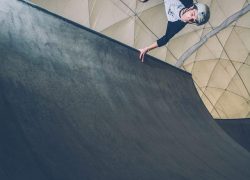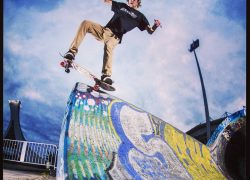Skateboarders used to limp a lot more. Now go back a few decades before anyone dressed in skate gear, before anyone looked so called skaterish-unless they were a skateboarder and gazed downward at the telltale sign. His shoes looked as if they been received from a trash disposal. Duck tape flapped from toecaps, broken laces were tied together, Shoe goo was globbed onto the torn material, and depending whether they were goofy or regular footed, an Ollie hole was burnt into one side of the shoe, exposing sock or even bloody skin. "some of the so called posers" would actually sit in their room and rub their sneakers against the grip to make it look as if they ollied all over the place. Trashed shoes were like a war wound, evidence on how hard you skated, not something to be embarrassed about. And most skaters limped at least part of the time from heel bruises, an incapable injury that occurred when running out of tricks with shoes lacking proper shock absorption.
In the world of shoes designed for skateboarding there was basically only one serous contender. With their off the wall model, vans concentrated on the grippness of the sole. The company's vulcanized rubber waffle soles were like melted gummy bears on the bottom of your feet. Converses chuck Taylors were also popular due to their thin soles, but everything about them was thin and they could be ruined in a day of skateboarding.
Skateboarding had exploded in popularity like never before at the tail end of the 70s but quickly withered to an anemic number of enthusiast's until the second half of the 80s. It didn't merely attract millions of alternative kids, it evolved from soulful stylish cruising to a punker trick orientated activity that gave birth to modern street skating. And the limping began skaters were jumping off ledges, blasting airs in pools, poping boneless over stairs, flipping mctwists on ramps and naturally bailing. Heel bruises, jacked shins, twisted ankles, and smashed toes forced skaters to cross over and seek out footwear that offered protection.
Skaters were advancing so quickly into unpredictable territory that their equipment couldn't keep up with the new demands. the pioneers of shoe development often carried bulk packages of shoe laces because they shredded so quickly and were artists who could bring a shoe back from the dead with shoe goo and a few feet of duck tape. By 1986 Nike air Jordan's, a basketball shoe, arguably the most popular skate shoe. The bones brigade rocks them throughout their most famous video, the search for animal chin, not because they were getting padded{they weren't} but because the shoes were designed to absorb shock, provide lateral support, and withstand the stress of the cutting and slashing of pro basketball players. And even then the shoes blew out quickly from Ollie's and knee sliding. They were far from the perfect skate shoe, but the design was a step in the right direction.
Airwalk challenged vans in the late 80s by advertising skate specific problems with their footwear designs. They had Velcro lace protectors and developed a multi colored high top sneaker built off the Jordan's that had a rubber pattern around the Ollie area. This was the first bulky leather shoe that could withstand the wear an tear of skating without needing globs of shoe goo. Unfortunately, most skaters were forced to dissect them and do everything from microwaving them. No joke- to cutting slats through the soles to improve flexibility. They were prefect for about one week before they were completely worn out. Regardless, they were a vast improvement over basketball shoes, and suddenly everyone wore them. Vison also released padded shoes designed for skating. These popular designs were the first few pebbles that started the great shoe avalanche that would rumble into malls and skate shops around the world.



